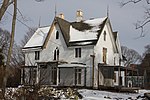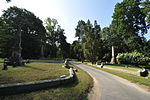Bristol County, Rhode Island
1747 establishments in Rhode IslandBristol County, Rhode IslandCounties in Greater BostonPages with non-numeric formatnum argumentsPopulated places established in 1747 ... and 4 more
Portuguese-American culture in Rhode IslandProvidence metropolitan areaRhode Island countiesUse mdy dates from December 2021

Bristol County is a county located in the U.S. state of Rhode Island. As of the 2020 census, the population was 50,793, making it the least populous county in Rhode Island. In terms of land area, it is the third-smallest county in the United States, at only 25 square miles (65 km2). The county was created in 1747 when it was separated from Bristol County, Massachusetts. Bristol County is included in the Providence-Warwick, RI-MA Metropolitan Statistical Area, which in turn constitutes a portion of the greater Boston-Worcester-Providence, MA-RI-NH-CT Combined Statistical Area.
Excerpt from the Wikipedia article Bristol County, Rhode Island (License: CC BY-SA 3.0, Authors, Images).Bristol County, Rhode Island
Hope Street,
Geographical coordinates (GPS) Address Nearby Places Show on map
Geographical coordinates (GPS)
| Latitude | Longitude |
|---|---|
| N 41.7 ° | E -71.28 ° |
Address
Hope Street 1249
02809
Rhode Island, United States
Open on Google Maps









